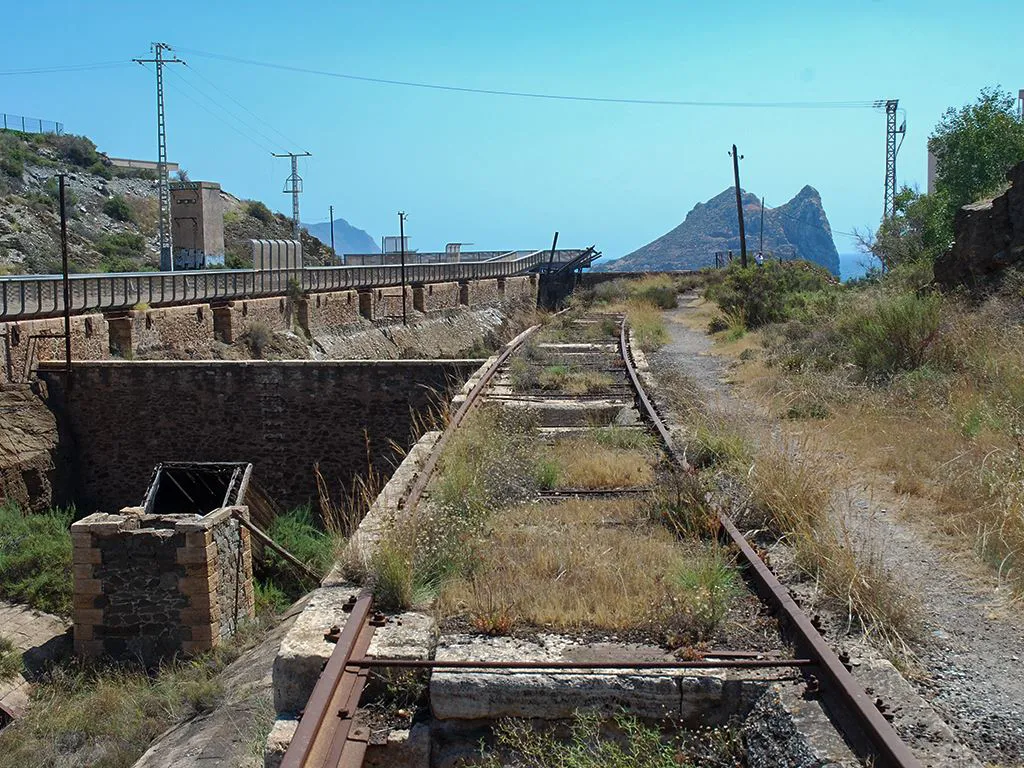The El Hornillo ore loading dock at Aguilas in Murcia province was the end of the line for the Great Southern of Spain Railway. It was not completed until 1903, too late to restore the financial fortunes of the company.
By Nick Nutter | Updated 25 Aug 2022 | Andalucia | History |
Login to add to YOUR Favourites or Read Later


El Hornillo Aguilas
Thanks mainly to the efforts of Gustav Gillman, the line was taking so much iron ore through to Aguilas port that the existing system of unloading the ore hoppers and transporting the ore to ships in the port by ox and donkey cart could not cope with the amount of ore arriving by train. The Águilas Port Co had a private line connecting it to the GSSR. There were seven turntables allowing access to the ore.


El Hornillo cargadero
A subsidiary of the port company, 'Mineral Loading Ltd.' installed a loading belt in 1908. This could handle 1,200 tonnes of ore per day, using 800kg wagons. This port was where much of the materials for the construction of The GSSR had been unloaded from ships. Nowadays there is nothing left of the old tracks, 7 turntables or cableways and the old track has been built over with apartments and bars.
For the grand finale we return to Aguilas and what proved to be Gustav Gillman’s finest achievement, the El Hornillo loading pier.


Mogul loco at Aguilas
The GSSR realised there would be a a problem loading the ore and in 1899 formed the The Hornillo Company Ltd. that from the beginning worked hand in glove with the GSSR. They shared the same office and most of the same company secretaries and the GSSR manager, Gustave Gillman.
To call El Hornillo a pier is a gross understatement. It was responsible for the transport of a huge proportion of iron ore from the mines in Las Sierras de Los Filabres. El Hornillo opened on 18th August 1903. It was 175 metres long and 14 metres high, set on concrete plinths.
The tracks were on two levels allowing ore to be stored in hoppers when there was no ship available. The ore could then be loaded onto trains in the tunnels once there was a ship available, which it would then pass on to the pier and load the ships via chutes. Due to the growth in trade, the hoppers were augmented to the point that El Hornillo could store 50,000 tonnes of ore.
The ships could only be loaded from the furthest third of the pier due to the shallowness of the water. This meant that only two ore wagons could discharge at a time per side, after which they would be in the way. This was neatly resolved by a section of track at the far end of the pier that could move horizontally, thus shuttling an empty wagon sideways. A third track was added later - to return the empty wagons.
The locos would push the goods trains into place and wait while each wagon was being unloaded through a chute underneath the wagon and then push the train one wagon-length forwards at a time.
The chutes were cleverly designed so that a train on the right track could load a ship on the left side and vice versa. All this was thanks to the genius of Gustave Gillman, a brilliant mining engineer and James Livesey, a railway designer.
To get the heavy trains up the steep ramp to the pier, they were split into two trains of 6 wagons (approximately 350 tonnes) and pushed by a Type 130 loco. Even then, the train had to have a number of run-ups before making it up the incline to El Hornillo, each time rolling back to Aguilas station 1 kilometre back down the line, much to the amusement of passengers waiting for their train.


Aguilas port railway station today
The building of the Great Southern of Spain Railway is one of the great achievements of 19th century, British engineering. Not so much for the ravines bridged and the mountains tunnelled, although they were considerable accomplishments, more for the indomitable will of the participants who faced challenges on every stretch of the line and overcame them.
Those challenges, some of which we have looked at in this series, all had financial implications and, even though the line was making £15 million per year in its heyday, that sum barely covered wages and running costs. The original investors in the Great Southern of Spain Railway Company Ltd. never recovered their investments.


The Great Southern of Spain Railway Ltd
The line was taken over by the Railway Workers Council at the beginning of the Spanish Civil War on the 17th July 1936. That should have been the last story but there is one more.
Twenty days before the handover, John Gillman, Gustave Gillman’s son, was made Managing Director of the GSSR. At the outbreak of the Civil War, he was imprisoned pending execution. Fortunately, he had friends in high places who organised his release and escape to Gibraltar.
And that is a story for another day.